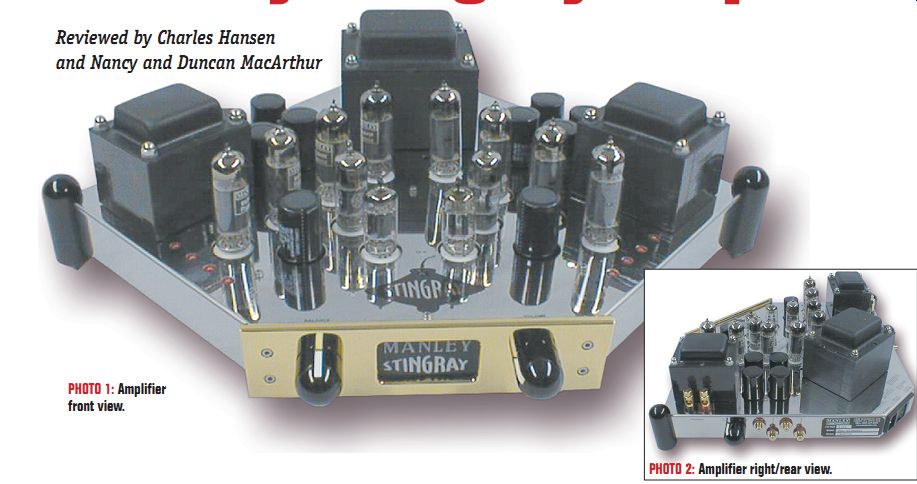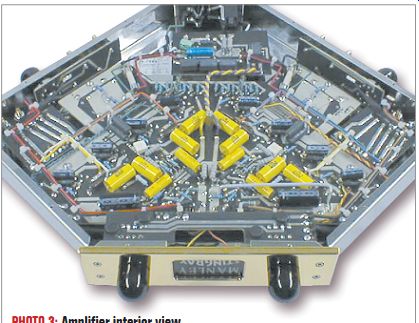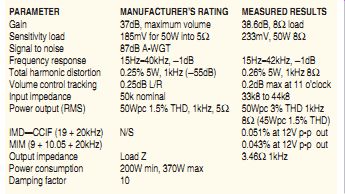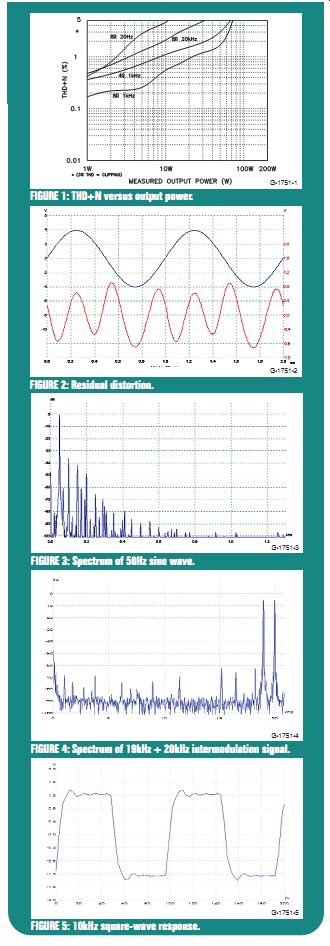Reviewed by CH and N. and D. MacArthur
--------------------
ABOUT THE AUTHOR
C H has worked as an engineer since 1967, and has five patents in his field of electrical engineering. He began building vacuum-tube audio equipment in col lege. He plays jazz guitar and enjoys modifying guitar amplifiers and effects to reduce noise and distortion, as well as restoring audio test equipment.
-----------------
Manley Laboratories, 13880 Magnolia Ave., Chino, CA 91710, (909) 627-4256, www.manleylabs.com, emanley@manleylabs.com.
Assembled: $2250. Dimensions:
6.5” H × 19” W × 15” D; net weight: 30 lbs.
Limited five-year warranty (tubes six months).

PHOTO 1: Amplifier front view.
PHOTO 2: Amplifier right/rear view.

PHOTO 3: Amplifier interior view.
The Manley Laboratories Stingray is a push-pull stereo integrated amplifier rated for 50W per channel. The heavy gauge, high-polish stainless steel amplifier chassis (designed and signed by EveAnna Manley) is a square whose corners have been truncated front and rear-more so in the front. Pointed solid aluminum footers are located on each side of the chassis, and two more elastomer footers are mounted underneath, for a four-point stance.
Photo 1 shows the gold-plated front panel, which has the balance and volume controls, and a power on indicator lamp behind the logo.
CONSTRUCTION
The right rear view (Photo 2) shows the four-position input selector switch and four high-quality gold plated Teflon-insulated RCA input jacks, and high-quality gold-plated ³/8” hex-nut speaker binding posts.
(RCA jacks and binding post are Manley's own design and manufacture.) The amplifier design is optimized for 5” speakers. To the right is a short rear panel with the IEC power receptacle and power switch.
On the top/front surfaces, eight test-point jacks allow you to monitor the bias for the eight EL84 out put tubes. A common bias-ground jack is located front/center at the tail of the silkscreened Stingray.
The bias for any of the EL84 out put tubes (250mV DC optimum) can be individually adjusted using trimpots recessed near the front of the power transformer.
The unit is furnished with a heavy power cord. The line fuse is located in a drawer in the IEC power receptacle. Two B+ fuses are located under the bottom cover.
The front-panel indicator lamp also resembles a 3AG fuse. The third pin of the AC receptacle is connected to the chassis. There is adequate finger space under the unit to easily lift it.
Photo 3 shows the amplifier with the perforated bottom cover re moved. The majority of the circuitry is contained on one large PC board, signed by the constructor.
Three small PC boards above each of the transformers provide a means of connection and, in the case of the Manley-designed power transformer, are fitted with four solid state 1000V 2A rectifier bridges and additional passive filter components. The 12AT7 and 6414 heaters receive rectified 12V DC. Three additional PC boards carry the front volume/balance pots and, at the rear/sides, the input jacks and selector switches. The few areas of interconnect wiring are beautifully dressed, with twisted pairs and coax used where needed.
The components are all of high quality, with Cornell-Dubilier, NIC, and Shoei electrolytics; custom polypropylene rolled film and foil caps; and military-style 1% metal film and 1% to 5% wire-wound resistors.
The illustrated owner's manual is complete and entertaining, with an excellent troubleshooting section. There are additional sections devoted to Optimizing Your Sound System, Replacing the Tubes, and Setting the Bias.
The Stingray is shipped with all tubes installed, held securely by a form-fitted foam rubber block with a hole for each tube. Very practical!
TUBE-POLOGY
A schematic was not supplied with the Stingray, but is available to registered owners upon request.
The input selectors and the Noble conductive plastic balance and volume controls form a passive stereo line stage. Inputs are labeled CD, Video, Tuner, and Aux.
The input stage for each channel is a 12AT7 dual-triode, followed by a 6414 dual-triode phase splitter.
The plates of the 6414 each drive a pair of parallel-connected EL84s in ultralinear push-pull. The output tubes receive grid bias from a negative bias supply. The output trans former secondaries (optimized for 5 ohm) can be connected to speakers with impedances of 3 ohm to 10 ohm. A very low level of global feedback is used in the Stingray amplifier. The manual cautions against operating the amplifier without a speaker load (open circuit).
There are ten Cornell-Dubilier type 380LX high-voltage electrolytic filter caps protruding through holes in the top of the chassis. Four series-parallel connected 330µF 350V DC caps in each channel provide the main B+ filtering, with a 220µF 450V DC cap next in the pi filtering string.
Manley supplied the following tube complement with the Stingray: 2-"Manley" 12AT7WAs from EI 2-GE NOS 6414s 8-Russian "Manley" EL84Ms (6p14 Military EL84/6BQ5 tube)
The two Manley-designed out put transformers do not appear as large as those of some other power amplifiers of this rating, but this is deceiving since the core stack is fairly high with one end-plate under the chassis.
PRELIMINARY CHECKOUT
There was no noise during power up, and only a slight noise during shutdown. There was no hiss and a very low-level hum from both channels with my ear against the speaker. This was independent of the volume-control setting.

TABLE 1
MEASURED PERFORMANCE

FIGURE 3: Spectrum of 50Hz sine wave.
FIGURE 4: Spectrum of 19kHz + 20kHz intermodulation signal.
FIGURE 5: 10kHz square-wave response.
FIGURE 1: THD+N versus output power.
FIGURE 2: Residual distortion.
MEASUREMENTS
I operated the Stingray at 10W into 8 ohm for one hour. The bias cur rent after this run-in was 240mV in each of the eight output tubes, which is certainly close enough to the specified 250mV. I made all measurements with the level control at 12 o'clock and an 8 ohm load, unless otherwise noted. The over all gain at this setting was 24dB.
The distortion was essentially the
----------------
Reviewed by Nancy and Duncan MacArthur
The Manley Stingray arrived in a single, light (30 lbs- no single-ended output transformers here) box. The amplifier and tubes, which were already mounted, were well-protected by custom-made foam inserts inside the box. The shipping materials were in much better shape than those of heavier amplifiers we have reviewed.
AESTHETICS
The Stingray immediately caused dissension in our household. Duncan and I were entranced by its looks.
"Retro," I breathed. "Beautiful," said Duncan. Colin, our ten-year-old, raised his eyebrows. "Ugliest thing I've ever seen," he said.
Regardless of your opinion of its looks, you probably won't find a CD player that "matches" it. On a more practical note, Manley suggests (and we agree completely) that the Stingray may not fit in a standard en closed equipment rack.
We think the Stingray looks good enough that you won't wish to hide it anyway. But this is a tube amplifier that generates a normal amount of heat. As all the tubes are completely exposed, the usual cautions about children and pets apply. The Stingray is supported by two sharp and two rubber pointed feet. We placed pennies under these points, but the machined "footer holders" that are widely available (for somewhat more than a penny) would work as well or better.
Given the price, the "fit and finish" of the entire amplifier is excellent. The small front panel holds volume and balance controls that operate smoothly and flawlessly in our sample. The placement of input selector switches on the rear panels would be inconvenient if frequent source changes were likely. As we only use one source (CD player), this characteristic didn't bother us. Similarly, the Stingray's power switch is located on the rear panel.
The location of these switches may be more than an inconvenience, as the speaker terminals are located on top of the chassis near the selector switches. Like most tube amplifiers, the Stingray should not be operated without a speaker load. Frequent reaching behind the amplifier to operate the input selectors could cause the speaker connections to loosen accidentally with potentially disastrous results.
LISTENING EXPERIENCE
All our auditioning was done using Genesis 400 speakers. These three-way floor-standing systems (not bi-amplified) are rated at 89dB/W efficiency but are 4 ohm designs with a fairly difficult impedance curve. We directly compared the Stingray with a pair of VTL "Tiny Triode" amplifiers. The VTL amplifiers use the same output tube complement (four EL-84s per channel) but strap these tubes for triode operation; as a result the output power of the VTLs is only 25W per channel. For reference purposes, the VTL amplifiers would receive sixes in all four categories in the ratings box.
The Stingray changed in small but important ways during the break-in period. Right out of the box, the bass and dynamics were impressive; however, the treble was a bit bright and the Stingray sounded more like a very good "hi-fi" amplifier and less like real music. About 50 hours of break-in was required before serious listening.
Following break-in we listened to the Hi-Fi News and Record Review disk III (track 2: Parry's " Jerusalem," track 4: Vivaldi's trumpet concerto, tracks 5 and 6: excerpts from Prokofiev's "Peter and the Wolf," track 7: Purcell's "Welcome, Welcome Glorious Morn," track 10: a Corkhill percussion piece, and track 14: Rio Napo RSS demo). We also played favorite tracks from a wide variety of musical genres ranging from classical to rock 'n' roll. In all cases the Stingray was turned on at least 30 minutes before serious listening.
This amplifier's ambiance recovery is impressive.
The Stingray clearly defined the open-air space around the choir in " Jerusalem" and the acoustic space around the trumpets in the Vivaldi. In "Misguided Angel" on the Cowboy Junkies' The Trinity Session (BMG Music Canada Inc. compact disk, 8568-2-R), the acoustic volume of the church in which the song was recorded stood out clearly.
The Stingray's lateral imaging is quite good. Its placement of trumpets in the Vivaldi concerto was pre cise and stable, as was its placement of the choir and trumpets in " Jerusalem." It gave an astonishing width of sound, extending well beyond the speakers, to the Rio Napo demonstration.
For an unusual imaging experience, try playing The Charlie Daniels Band's "The Devil Went Down to Georgia" (Fiddle Fire, Blue Hat Records compact disk, BLH-9703-2) on this amplifier and listening for the screech shooting from left to right across the soundstage partway through the song. The image depth extended back only a short distance behind the speakers on most tracks and was, in our opinion, the Stingray's weakest characteristic.
This amplifier produces a strong, natural bass. The bassoon on tracks 5 and 6, "Peter and the Wolf," sounded like a real bassoon playing in the listening room. The sound of the timpani was deep, well-defined, and almost scary.
Since our Genesis speakers are "only" flat to 40Hz, we were unable to check out the Stingray's capacity to reproduce extremely deep bass. We tried playing Tchaikovsky's "1812" Overture (Cincinnati Symphony Orchestra, Erich Kunzel, Telarc compact disc, CD-80041). The cannon shots sounded surprisingly realistic, although, of course, they lacked the last octave or more of bass.
The Stingray's midrange is excellent. One of this amplifier's greatest strengths is its superb reproduction of the human voice. Whether we were listening to opera or Bob Dylan, every note, rasp, and tremor stood out clearly. Solo piano pieces also sounded completely realistic. As illustrated in the Rio Napo demo, the Stingray's highs are very clean and clear. In "Peter and the Wolf," the flute sounded like a real flute.
One caution: if your speakers tend towards brightness, a home audition is definitely in order before you purchase the Stingray. The Stingray was quite merciless in reproducing poor recordings.
The Stingray provides exceptionally fast transient response. The attack on the drum sounds in the Corkhill piece was fast and dynamic. This amplifier also handles extreme differences in loudness gracefully. On "Peter and the Wolf," the dynamic difference between single groups of instruments and the entire orchestra was staggering, as was the dynamic contrast between the soft and loud drums on the Corkhill piece. The Stingray never sounded compressed, even at earsplitting levels.
This amplifier consistently delivers a realistic, natural sound. In "Peter and the Wolf," Purcell's "Welcome, Welcome, Glorious Morn," and the Rio Napo demonstration, the individual instruments were easily distinguishable and well-defined. The massed strings and trumpets in track 4, the Vivaldi trumpet concerto, sounded realistic and never got "steely." As we mentioned earlier, voices and piano were amazingly detailed and realistic.
A final note: we seldom listen to "sound effects" recordings, but track 18 of the test disk included a recording of a dentist's drill that the Stingray reproduced so faithfully at realistic volumes that it always cleared the room.
FINAL THOUGHT
NM: The nines in the ratings box do not convey the sheer pleasure of listening to this amplifier. Very highly recommended, unless depth is your main purchasing criterion or you own bright speakers. DM: Is the Stingray the best integrated amplifier avail able ? I don't know-I haven't heard all of the contenders.
Is the Stingray perfect? No. The imaging, especially the reproduction of depth, was very good but not "jaw dropping." The highs were crystal clear and could be come excessive if the Stingray were coupled to bright speakers.
Is the Stingray the best amplifier I've ever had in my listening room ? Yes.
Would I consider buying the Stingray?
Yes; and so should you if your budget allows.
CRITIQUE SONIC CHARACTERISTICS RATINGS
DM NM Presence DM NM Stereophonic Effect DM NM Soundstaging DM NM Ambiance 12345678910
ABOUT THE AUTHORS:
Nancy and Duncan MacArthur live in northern New Mexico with their young son, Colin. Nancy has written for Audio Amateur and Speaker Builder, as well as for Glass Audio. Duncan works as a physicist. In addition to equipment reviewing, he designs and constructs audio components and state-of-the-art detection systems.
-----------------------------
... same for each channel. The right channel test data is presented here, and summarized in Table 1.
The Stingray does not invert polarity. Input impedance for both channels measured 44k8 at mini mum volume, and 33k8 at the maximum volume setting. The full-volume gain at 2.83V RMS output into the 8 ohm load was 38.6dB. The output impedance was 3.5 ohm at 1kHz, and 3.7 ohm at 20kHz.
The amplifier frequency response will be affected by any speaker impedance variations.
The frequency response for the Stingray was within ±3dB from 9Hz to 55kHz, with 0dBr defined as 2.83V RMS at 1kHz into 8 ohm. It was -0.7dB at 20Hz and -0.3dB at 20kHz. The HF gain rolled off smoothly to -8.3dB at 80kHz, then there was a gain "peak" to -5dB at 97kHz. When I connected a load of 8 ohm paralleled with a 2µF cap, the HF peaking shifted down to 50kHz.
Channel separation measured -70dB at 1kHz, -60dB at 10kHz, and -53dB at 20kHz L-R. Figure 1 shows THD+N versus output power into 8 ohm at 20Hz, 8 ohm at 20kHz, 4 ohm at 1kHz, and 8 ohm at 1kHz (top to bottom at 10W). There was absolutely no strain right up to the point of maximum power.
The clipping level is normally defined as that power where THD+N reaches 1%. However, the baseline distortion in tube amplifiers is fairly high at low power levels, so the generally accepted practice is to use 3% THD+N as the clipping point.
Using a 1kHz signal driving both channels, clipping occurred at exactly 50W into both 4 ohm and 8 ohm. The power available at 20Hz and 3% THD+N was only 5.5W. At 20kHz I measured 15W into 8 ohm at 3% THD+N. The maximum power available at 1kHz was 86W into 4 ohm and 78W into 8 ohm, at a high 15% THD. The clipping was symmetrical and quite flat-topped for a tube amplifier (56V p-p). Perhaps the designers caused clipping to occur in the input stage rather than the output tubes. Maximum power at 20Hz was just 21W at 10% THD+N, but at 20kHz
I measured 55W at 10% THD+N. My test bench 60Hz mains voltage was 119V AC. After these tests, the power transformer and output transformers were fairly hot.
The distortion waveform for 10W into 8 ohm at 1kHz is shown in Fig. 2. The upper waveform is the amplifier output signal, and the lower waveform is the monitor output (after the THD test-set notch filter), not to scale. This distortion residual signal shows only low-order harmonics, with no evidence of any noise or fuzz.
The spectrum of a 50Hz sine wave at 10W into 8 ohm is shown in Fig. 3, from zero to 1.3kHz. The THD+N measured 1.84%, with the second, third, fourth, and fifth measuring -36dB, -42dB, -49dB, and -66dB, respectively. There are several artifacts of power supply rectification at 60Hz (-60dB), 120Hz (-84dB), and 180Hz and 240Hz below the -60dB line.
Figure 4 shows the Stingray's output spectrum reproducing a 12V p-p combined 19kHz + 20kHz intermodulation distortion (IMD) signal into 8 ohm. The 1kHz IMD product is 0.051%. Repeating the test with a multi-tone IMD signal (9kHz + 10.05kHz + 20kHz, not shown) resulted in a 1kHz product of 0.043%.
The 2.5V p-p square wave into 8 ohm at 40Hz showed a tilt of 45°.
The 10kHz square wave (Fig. 5) contained ringing at the 97kHz peaking measured in the frequency-response test. This ringing was also noticeable at the leading edge of the 1kHz square wave. When I connected 2µF in parallel with the 8 ohm load, the leading edge became more rounded, and the ringing frequency dropped to about 50kHz.
Manufacturer's response:
Thank you all so very much for the hard work and effort in reviewing our Stingray. We are very pleased it did so well in your stringent battery of tests even at less-than-its-optimized 8 and 4 ohm. We've always been a 5 ohm company for some reason.
EveAnna Manley President Manley Laboratories, Inc.
Also see: